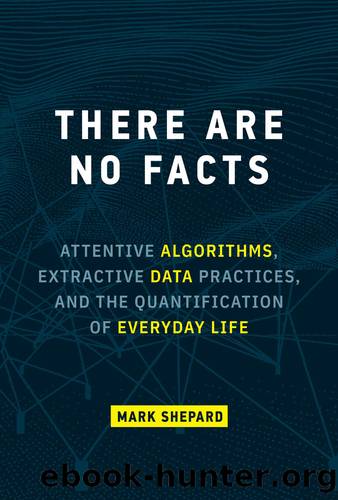There Are No Facts by Mark Shepard

Author:Mark Shepard
Language: eng
Format: epub
Tags: post-truth; data; algorithms; machine learning; attention; perception; space; spatial epistemology; behavior; everyday life; smart home; smart city; socio-technical systems; public space; cartography
Publisher: MIT Press
TEST-BED NEIGHBORHOODS
While platforms such as Placemeter add big data and machine learning to the instruments available for the research and design of urban environments, other initiatives look toward the instrumentalization of the urban environment itself. New York Cityâs Hudson Yards project is the largest private real estate project ever to be built in the United States. When completed, the $20 billion projectâwhich spans the seven blocks of Thirtieth to Thirty-Fourth Street cordoned by Tenth and Twelfth Avenuesâwill add 17 million square feet of commercial, residential, and civic space.12 Initial reports claimed that it would contain the nationâs first quantified community, a test bed for applied urban data science.13 Led by Constantine Kontokosta, a professor of urban informatics at NYUâs Center for Urban Science and Progress (CUSP), the quantified community, as he refers to it, aimed to be a fully instrumented urban neighborhood that would use an integrated, expandable sensor network to support the measurement, integration, and analysis of neighborhood conditions, activity, and outcomes.14
The premise of the quantified community is drawn from the quantified self trend. People associated with this trend employ fitness activity trackers to monitor a range of health factorsâfrom heart rate, to steps taken, floors climbed, calories burned, even sleep qualityâand to produce representations of their progress toward self-identified goals that are shared and aggregated through online portals.15 In another form of life logging, dieting apps enable us to record what we eat and track how many calories we have consumed; what proportion of those calories are from protein, carbohydrates, or fat; and provide nutrition information about daily eating habits. Central to this movement is the idea that these personal monitoring devices can support behavioral change.
Scaling this paradigm to the neighborhood, the notion of the quantified community posited that the continuous monitoring of the built environment, from its technical systems to the human activity within it, could be fed back into that environment so as to alter its future performance and the behavior of its inhabitants. Kontokosta himself explicitly identified his behaviorist intentions for the quantified community: âMy focus is much more on understanding how the data influences behavior,â he has said, âand using the type of information thatâs now available to really democratize the planning process much more.â16 Kontokostaâs version of the quantified community aimed to measure, model and predict a wide range of activity, including pedestrian flows through traffic and transit points, open spaces, and retail space; air quality both within individual buildings as well as across open spaces and surrounding public areas; health and activity levels of residents and workers using a proprietary smartphone app; and solid waste with particular focus on increasing the recovery of recyclables and organic waste, energy production and usage throughout the projectâs life cycle.17 The quantified community at Hudson Yards promised a test bed for future urban life, where urban intelligenceâthe âsmartnessâ of the smart cityâwould be rendered not as conscious, liberal, or objective but rather as performative.
If Vertovâs film presented the collapse of distance and distinction between observer and
Download
This site does not store any files on its server. We only index and link to content provided by other sites. Please contact the content providers to delete copyright contents if any and email us, we'll remove relevant links or contents immediately.
Algorithms of the Intelligent Web by Haralambos Marmanis;Dmitry Babenko(16234)
Azure Data and AI Architect Handbook by Olivier Mertens & Breght Van Baelen(7674)
Building Statistical Models in Python by Huy Hoang Nguyen & Paul N Adams & Stuart J Miller(7655)
Serverless Machine Learning with Amazon Redshift ML by Debu Panda & Phil Bates & Bhanu Pittampally & Sumeet Joshi(7529)
Driving Data Quality with Data Contracts by Andrew Jones(7293)
Data Wrangling on AWS by Navnit Shukla | Sankar M | Sam Palani(7290)
Machine Learning Model Serving Patterns and Best Practices by Md Johirul Islam(7030)
Learning SQL by Alan Beaulieu(6237)
Weapons of Math Destruction by Cathy O'Neil(6214)
Big Data Analysis with Python by Ivan Marin(5933)
Data Engineering with dbt by Roberto Zagni(4931)
Solidity Programming Essentials by Ritesh Modi(4565)
Time Series Analysis with Python Cookbook by Tarek A. Atwan(4399)
Pandas Cookbook by Theodore Petrou(4086)
Blockchain Basics by Daniel Drescher(3540)
Natural Language Processing with Java Cookbook by Richard M. Reese(3143)
Hands-On Machine Learning for Algorithmic Trading by Stefan Jansen(3043)
Learn T-SQL Querying by Pam Lahoud & Pedro Lopes(2930)
Feature Store for Machine Learning by Jayanth Kumar M J(2925)
